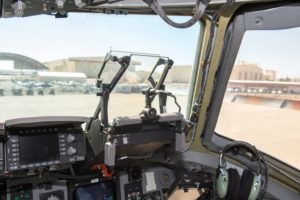
The U.S. Air Force is undertaking a number of avionics upgrades for Boeing [BA] C-17 and Lockheed Martin [LMT] C-130H transport aircraft, as the supplier base for legacy avionics systems falls, according to the Air Force Life Cycle Management Center (AFLCMC) at Wright-Patterson Air Force Base, Ohio.
“Diminishing Manufacturing Sources Material Shortfalls (DMSMS) are driving avionics-related upgrades,” AFLCMC wrote in email responses to questions from Defense Daily.
“The C-17 aircraft was last produced in 2015 and with it most of the unique avionics boxes are no longer in production nor available to be purchased,” according to the AFLCMC C-17 program office (AFLCMC/WLM) at Robins AFB, Ga. “The C-17 program has been notified on most avionics systems the availability of electronic piece parts are already or will become no longer available to make repairs to avionics boxes. Piece part vendors change product lines due to the continual evolution of the electronics industry to support modern electronics systems in production with great capability.”
The Air Force C-17 contract with Boeing provides “for notification when a supplier projects repair of a C-17 part will no longer be supportable,” according to AFLCMC/WLM. “To continue support of C-17 aircraft avionics, options available to mitigate the DMSMS issue include lifetime buy of the piece parts required for repairs, re-engineering of the next higher assembly, or a complete redesign of the part.”
AFLCMC/WLM is undertaking a nearly $286 million C-17 Replacement Head-Up Display (RHUD) program with Elbit Systems of America to replace the 1980s-era C-17 HUD by the defunct U.K.-based GEC Avionics, which became BAE Systems Avionics and is now part of Leonardo.
“BAE Systems has notified the Air Force that the ability to repair the C-17 Legacy Head-Up Display (LHUD) is limited due to unavailability of piece-parts supplied by sub-vendors required to make the LHUD repairs,” according to AFLCMC/WLM. “The LHUD is specific to the C-17 aircraft.”
The Elbit Systems RHUD for the C-17 has a Projector Unit (PU) and a Computer Unit (CU) that “displays symbols and real-world conformal imagery over an increased field of view to include the capability to display threat warnings and quadrant, supports two independently selectable video inputs for autonomous landing growth requirements, provides aircraft Electronic Bore-sighting capability, [and] provides improved reliability with a Mean Time between Failure (MTBF) of 3,000 operating hours,” according to AFLCMC/WLM.
A GEC Avionics brochure issued in 1987 for the C-17 HUD said that the HUD has an MTBF of 7,000 operating hours, but, “based on current performance, the actual [HUD] MTBF is between 1,600 and 1,800 hours (lower than predicted),” according to AFLCMC/WLM. “The Statement of Requirements for the Replacement Head Up Display (RHUD) development delivery order requested 3,000 hours MTBF at maturity.”
In addition, for the Boeing C-17 aircraft, the Air Force is undertaking “satellite communications upgrades for increased coverage and throughput speeds along with mitigation of obsolescence issues due to satellite service dates” and “upgrades of legacy aircraft avionics to capabilities of current commercial production aircraft, large area displays, [and] improved weather radars,” AFLCMC/WLM said.
Under a $209 million Beyond Line of Sight (BLOS) program for the C-17, AFLCMC is replacing the aircraft’s L-Band Aero-I and Aero-H antennas, providing air traffic control data link capabilities, replacing the Collins Aerospace [UTX] ARC-210 Gen 3 radios with ARC-210 Gen 6 radios, and replacing KYV-5 cryptography with next-gen KYV-5M, AFLCMC/WLM said.
Last July, the Air Force picked Honeywell [HON] to install its JetWave Ka-band fuselage-mounted antenna (MCS-8100 and tail-mounted antenna (MCS-8000) on 70 C-17s to provide real-time weather, video conferencing, large file transfer, encryption capabilities, in-flight briefings, intelligence surveillance reconnaissance video and secure communications in all areas, including over water and remote areas. The C-17 BLOS program will “enable dynamic re-tasking and command and control support of MAF [Mobility Air Forces] aircraft,” the Air Force said. JetWave uses Inmarsat‘s Global Xpress Ka-band service to provide worldwide connectivity with up to 50 Mbps of bandwidth to defense customers, according to Honeywell Aerospace.
In December, AFLCMC completed Block 21 upgrades for all 275 C-17s, operated by the Air Force and allied nations, according to AFLCMC/WLM. The upgrades included hardware and software for Automatic Dependent Surveillance-Broadcast Out (ADS-B Out) required by the U.S. Federal Aviation Administration and aviation authorities in Europe for planes operating in controlled airspace.
“In addition to ADS-B Out, Block 21 included an Identification of Friend or Foe (IFF) modification and other communication/navigation capability software updates,” AFLCMC said. “These additional modifications significantly improve the aircraft’s flight management systems.”
For the C-130H, the Air Force last June awarded L3Harris [LHX] a nearly $500 million contract for avionics upgrades to 176 Air Force Reserve and Air National Guard aircraft under the C-130H Avionics Modernization Program (AMP).
L3Harris has chosen Collins Aerospace to provide its commercial off-the-shelf Flight2 integrated avionics system. Collins Aerospace said that is providing seven multifunctional displays (MFDs), three control display units (CDUs), and a new digital autopilot that will replace more than 100 analog instruments in C-130H cockpits.
The AFLCMC C-130 program office (AFLCMC/WLN) at Robins Air Force Base said that the C-130H AMP increments 1 and 2 include “compliance with latest commercial and military Position, Navigation, and Timing (PNT) standards, a new flight management system, new commercial and military GPS receivers, improved [RNP] Required Navigation Performance], compliance with VHF 8.33KHz channel spacing requirements and ADS-B Out and Mode S Enhanced Surveillance (EHS) requirements, military satcom voice and data via the Lockheed Martin Mobile User Objective System (MUOS), improved UHF anti-jam capability via the Collins Aerospace Second generation Anti-jam Tactical UHF Radio for NATO (SATURN), Real-Time Information into the Cockpit (RTIC), Link 16, [and a] digital map.”
The C-130H upgrades also include a terrain awareness and warning system (TAWS), according to AFLCMC/WLN. RTIC is to allow the C-130H aircraft to share data with other systems over multiple data link networks.